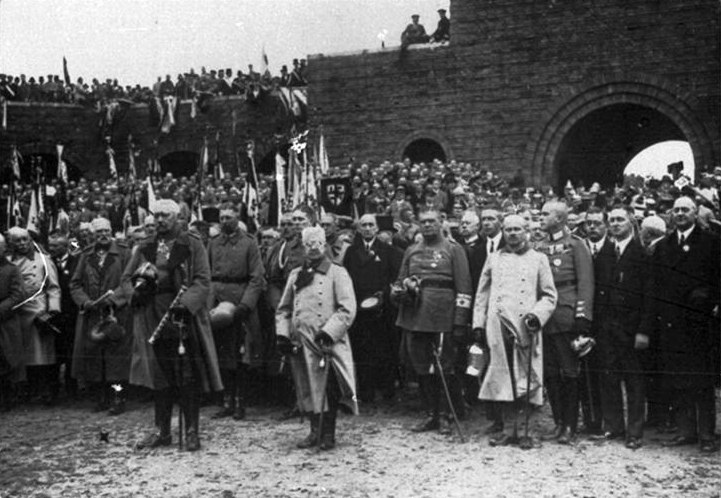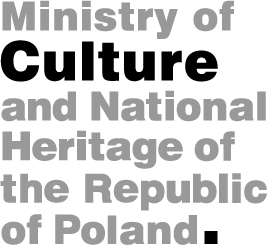|
|
the chronicle of the memorial The celebration of the blessing, which was also the opening of the Tannenberg-Denkmal took place on 18 September 1927. Because building work was in progress, while the 80th birthday of Marshal Hindenburg was approaching (2 October), the celebrations were moved for the first time to the 18th day of September, becoming in effect a spectacular, historic event. Despite bad weather, something between eighty thousand and one hundred thousand people arrived in Olsztynek in forty special trains. The opening was exceptionally solemn and lofty, nevertheless, the local media reported it using a critical tone (see: Poświęcenie pomnika, Gazeta Olsztyńska no. 218). A subsequent, important celebration in the history of the memorial had a local – East-Prussian character. This happened on 25 August 1929. 55 plaques and monuments devoted to the fallen soldiers from particular army units which had taken part in the battle in 1914, were blessed. According to minister Poshmann (who took part in the blessing of the plaques and monuments), this gesture, performed before the eyes of the gathered crowds, made many people realise how valuable one's homeland, country and the German nation is in the face of such loss. The number of participants of the celebration was assessed to be between 150,000 and 20,000 people. It is worth mentioning that the care of the memorial and its lawful use for ideological goals was performed by The Government of the Association of the National Tannenberg Memorial, chaired by General Hans Kahns. Among the members of this organisation were high ranking members of the state administration and self-government, along with industrialists and military men – a group of people with national-conservative bias. From the very beginning of its existence, members of this group as well as representatives of the East-Prussian authorities, with the help of public opinion, tried to initiate an all-German discussion in order to acclaim the memorial the central war symbol of Germany (Reichsehrenmal). Additionally, a special commission, propagating the idea of the creation of the national German symbol of Tannenberg-Nationaldenkmalwas created in Olsztyn to reinforce support for the idea. Decisively, the largest celebration in the history of the memorial, both in its social and political dimensions, was the death of the President of the Reich Paul von Hindenburg on 2 August 1934. On Hitler's orders, Albert Speer became the supervisor for the organisation of the funeral on the premises of the Tannenberg Memorial. Initially, in accordance with the project of the Krüger brothers, it was planned that Hindenburg would be put to rest in the central point of the yard, under the Cross. These plans were changed, however, and a special crypt was build in the former exit tower, a huge monolith with Hinderburg's name being placed over the entrance. The cross was also replaced by a paved field for military parades, the central point for official anniversary meetings. Funeral celebrations with the participation of the highest German authorities and foreign representatives took place on 7 August 1934, with the Field Marshal's coffin being placed in the crypt to the accompaniment of tolling bells and cannon shots. Hitler, present at the funeral, delivered a farewell speech of an openly pagan nature: "In this place, among the infantry soldiers from victorious regiments who are sleeping here, our tired general will find his place of rest. Our Late General – enter you your Walhalla now!". At Hitler's request, the monument was given the name of "The Memorial of Those Fallen at Tannenberg" in 1935, (Reichsehrenmal Tannenberg – historiography also shows the name Hindenburg's Mausoleum). Hindenburg's body rested there until January 1945. That is, until the Germans, fearing the sacrilege of the Russian army, managed to salvage the coffin, with his remains, at the last moment, transporting it deep into the German lands. Currently, the remains of the Field Marshal rest at St. Elisabeth's Church in Marburg on the River Lahn in Hesse Land. Translated by Marzena Beata Guzowska
|

Official opening of Tannenberg-Denkmal, 18.09.1927. Field Marshal Hindenburg on the left. 
The effigy of the Lion devoted to the memory of the fallen soldiers of the 147 Infantry Regiment by the Italian sculptor Michelangelo Pietrobelli. 
Walter and Johannes Krüger with Erna Becker-Kahns realised a fountain in the form of a horse pond as a monument to the horses fallen in the historic battle in 1914. |
|||
| |||||
